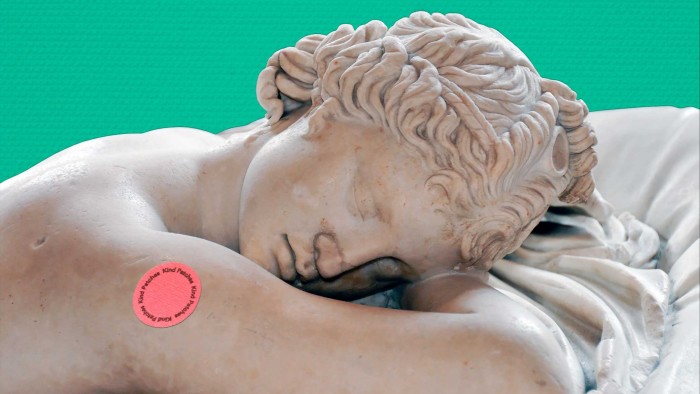Unlock the Editor’s Digest for free
Roula Khalaf, Editor of the FT, selects her favourite stories in this weekly newsletter.
Still resorting to paracetamol and a pint of water to cure your hangover? There’s a patch for that. Stick-on solutions are fuelling the $1.8tn global wellness market: much like those used to quell nicotine cravings or up oestrogen levels, a new crop of wearable patches promises to soothe period pains, boost vitamins, calm anxiety, improve sleep – and bust your hangover.
If you’re someone who covered their school books in stickers or has dabbled in star-shaped pimple patches, you’ll understand the transgressive allure of wellness patches. (Even 17th-century Europeans wore decorative velvet patches to conceal smallpox scars.) Some have aesthetic appeal: Barrière’s vitamin and adaptogen patches comprise delicate designs of butterflies and seashells resembling temporary tattoos. Others are intriguing in their mundanity: Kind Patches’ colourful circles promise to enhance libido (cherry red) and collagen levels (orange).
The fact that many of these patches occupy a regulatory grey area between cosmetics, medical devices and vitamins, with meaningful benefits difficult to discern, hasn’t stopped the category from booming. The global wearable patch market – which includes patches for disease monitoring and drug delivery, and was estimated at $9.95bn in 2024 – is projected to grow at a compound annual growth rate of 8.1 per cent between 2025 and 2030. Broadly speaking, wellness patches fall into three camps: transdermal devices that purport to deliver micronutrients through the skin to the blood, cosmetic patches that administer agents locally in the skin and aromatherapeutic patches that diffuse essential oils. The appeal of the first is convenience. “We’ve all got houses full of half-empty vitamin bottles knocking around,” says Kelly Gilbert, a former Vogue beauty editor who launched supplement brand The What Supp Co in January. It currently offers three transdermal vitamin patches: Dip Out for anxiety, which contains the amino acid L-theanine and valerian root; Protect Your Energy for fatigue, containing B vitamins; and Recovery Mode, for detoxing after heavy meals or drinking sessions, containing milk thistle and zinc (£18 for 15 patches).
The What Supp Co’s UK-made slow-release patches (completed within 10 to 12 hours) use ingredients with a molecular weight of under 500 daltons that, Gilbert says, allows for effective absorption through the skin barrier. They’re also fun, coming in bright colours and cute shapes. This month, Gilbert will launch Looks Good On You, containing copper peptides, zinc and antioxidants for healthy skin and hair. LVMH-owned beauty retailer Sephora sees the potential: it gifted The What Supp Co patches to attendees of its influential Sephora Brand Summit in February.
Botanical-based patches are equally fashionable. The London-based acupuncturist Ross J Barr first developed his aromatherapy patches (as well as oral supplements) during the pandemic, when he was unable to treat patients due to lockdown regulations. The business has grown 139 per cent year on year. “The aim is the activation of an acupuncture point,” he says. Formulated in the UK, the oil-infused fabric Calm patches containing safflower and white peony are particularly effective when placed on the temples – once you get used to the funky herbal whiff. Meanwhile, the Sleep patches containing herbs such as wild jujube seed and polygala are a hit with guests who find them in Claridge’s minibars. Barr says his returning customer rate is up 70 per cent on last year.
Patches also tap into a trend for conspicuous wellness devices – such as Oura’s biometric rings – with consumers prioritising products that blend healthcare with self-expression. “I liked the idea of non-verbal cues that indicate how you’re feeling,” says The What Supp Co’s Gilbert. Selfridges’ beauty buyer Millie Harris agrees. Selfridges began stocking Ross J Barr’s aromatherapy patches in December 2022; last year the brand was the fastest-growing in the retailer’s wellbeing category. “The sensory ritual of applying a patch is definitely central to the appeal,” says Harris. “Women might apply their Calm patches together during a particularly stressful moment at work. There’s something unifying about sharing a concern in a more visible way.” Highly visible products such as patches “particularly resonate for Gen Z”, adds McKinsey partner Anna Pione, “as it allows them to feel like they are standing out while also being part of a community”.
But not all patches are created equal. Stuart Jones, a professor of pharmaceutical medicine at King’s College London, cautions that the skin is “a really good barrier”, pointing out that delivery of active ingredients to the blood in meaningful quantities is challenging. In addition, “it’s quite difficult to make an adhesive patch where the actives actually come out of it”, Jones explains. “But, of course, if the actives don’t come out, the patch is extremely safe.” Jones is now developing a transdermal patch that delivers vitamin D directly to the bloodstream by adding a phosphate group to the vitamin D molecule, promising to deliver almost 300 times the amount through the skin compared with a marketed vitamin D patch.
Jones advises consumers to carefully check labels to assess any claims. “Some claims – for example, ‘contains vitamin E’ – don’t relate to the clinical performance of the patch. The onus is on the manufacturer to make sure the product is safe; it doesn’t mean that it’s effective.” Jones has completed what he believes to be the most robust clinical trial on humans ever of a vitamin D patch, and plans to launch his own later this year. He cautions those who are using vitamin patches to combat deficiency to check in with their doctor regularly. “The consumer needs to try and distinguish between patches that have been clinically tested and proven, and patches that haven’t. It’s buyer beware.”
Read the full article here

